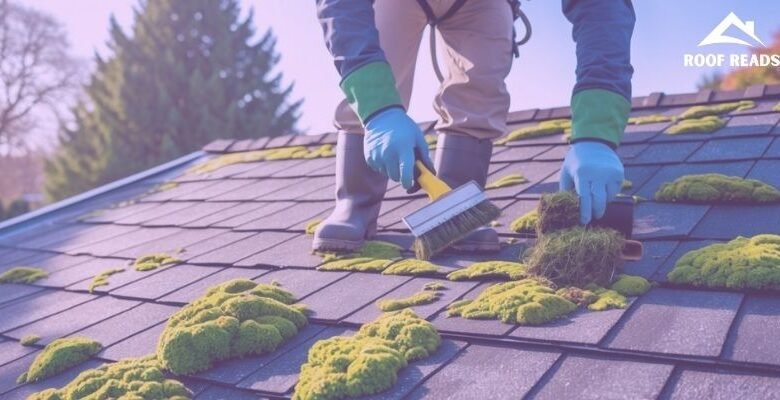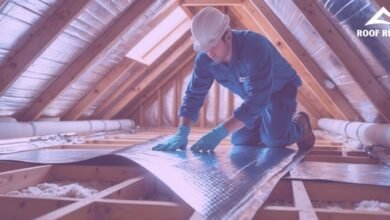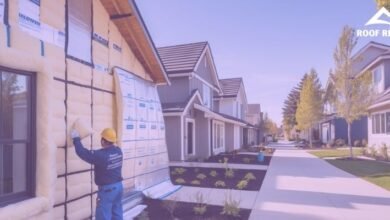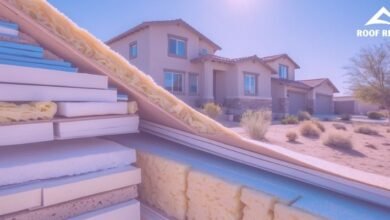How to Remove Moss from Roof: A Complete Guide for Effective Cleaning

Moss growing on your roof isn’t just an eyesore—it can damage your shingles and lead to costly repairs if left untreated. Removing moss involves a simple process that most homeowners can handle with the right tools and safety precautions. To remove moss effectively, you’ll need to scrub it away with a soft-bristled brush working from the bottom of the roof upward, then apply a cleaning solution to prevent regrowth.
The best time to tackle moss removal is on a cloudy day when cleaning products won’t evaporate too quickly. You can use commercial moss killers or natural alternatives like a baking soda solution. After applying your chosen solution, let it sit for 20-45 minutes before gently scrubbing and rinsing the roof.
Key Takeaways
- Moss should be physically removed with a soft-bristled brush working from the bottom up to avoid damaging shingles.
- Apply cleaning solutions on cloudy days and allow them to sit for at least 20 minutes before rinsing the roof.
- Increasing sunlight exposure and improving roof ventilation helps prevent future moss growth on your roof.
Understanding Moss Growth on Roofs

Moss growth on roofs is a common issue that affects many homeowners, especially in damp and shaded environments. When left untreated, this seemingly harmless plant can lead to significant damage and costly repairs.
Why Moss Grows on Roofs
Moss thrives in moist, shaded conditions where sunlight is limited. It reproduces through tiny spores that are carried by wind or animals and settle on roof surfaces.
North-facing roof sections receive less direct sunlight and stay damp longer, making them ideal spots for moss development. Areas with overhanging trees create shade and drop debris that traps moisture.
Moss doesn’t need soil to grow. It can attach directly to roofing materials and absorb water through its leaves rather than roots. This allows it to survive and spread across roof surfaces.
Climate plays a crucial role too. Regions with high rainfall, humidity, and moderate temperatures create perfect conditions for moss growth. The Pacific Northwest and Northeast United States are particularly prone to moss problems.
Common Roofing Materials Vulnerable to Moss
Asphalt shingles are highly susceptible to moss damage. The granular surface provides an excellent foothold for moss to grip, while the organic materials in older shingles can serve as food.
Wood shingles are extremely vulnerable as they absorb moisture easily. Moss can quickly embed itself between wooden shakes, accelerating decay and deterioration.
Concrete and clay tiles have porous surfaces that trap moisture and provide nooks where moss spores can settle. The texture gives moss plenty of surface area to cling to.
Metal roofing is generally more resistant but isn’t immune. In shady, moist conditions, moss can still form on metal surfaces, particularly at seams and joints where debris collects.
Risks Associated With Moss-Covered Roofs
Structural damage is the primary concern with moss growth. As moss holds moisture against roofing materials, it accelerates deterioration and rot, especially in wooden components.
Moss can lift shingles and tiles, creating gaps where water can seep underneath. This leads to leaks and potential water damage to the interior of your home.
The added weight of moss, especially when saturated with water, puts extra stress on your roof structure. In extreme cases, this can compromise the roof’s integrity.
Moss growth reduces a roof’s ability to reflect sunlight, potentially increasing cooling costs during summer months. It also traps debris, blocking proper drainage and causing water to pool.
Home value can decrease significantly due to the unsightly appearance of a moss-covered roof. Potential buyers may worry about hidden damage or maintenance issues.
Safe and Effective Methods for Removing Moss

Removing moss from your roof requires the right approach to protect both your roof materials and your safety. Several proven methods can effectively eliminate moss growth without causing damage to shingles or tiles.
Manual Roof Moss Removal Tools and Techniques
Manual removal works well for small moss patches and prevents chemical runoff. Start with a soft-bristle brush specifically designed for roof cleaning. Never use metal brushes or pressure washers as they can damage shingles and void warranties.
Work in a downward motion from the roof’s peak to avoid lifting shingles. A plastic scraper can help with stubborn patches. For better reach, attach your brush to an extension pole.
Long-handled roof rakes designed for moss removal allow you to work from the ground in some cases. This approach is safer than climbing onto the roof.
Let the roof dry completely after manual removal before applying any preventative treatments. Inspect the cleared areas for damaged shingles that may need repair.
Chemical and Natural Moss Removal Solutions
Both chemical and natural solutions can effectively kill moss. For a natural approach, mix equal parts white vinegar and water in a spray bottle. Apply on a cloudy day to prevent quick evaporation.
Baking soda creates an alkaline environment hostile to moss. Sprinkle it directly on moss-covered areas or mix with water to create a paste for thicker growth.
Oxygen bleach provides effective cleaning without damaging most roofing materials. Mix according to package directions and apply with a garden sprayer.
Commercial moss killers typically contain zinc or potassium salts. These products should be left on the roof for at least 20 minutes to properly absorb into the moss.
After applying any solution, wait until the moss turns brown or black (usually 1-2 weeks), then gently remove it with a soft brush.
DIY Moss Removal Safety Precautions
Safety must be your priority when removing roof moss. Always work with a partner who can hold the ladder and call for help if needed.
Wear non-slip footwear, preferably rubber-soled shoes with good traction. Use a properly secured extension ladder with stabilizers that extends at least 3 feet above the roof edge.
Protective gear is essential: wear gloves, safety glasses, and a dust mask to prevent irritation from moss spores and cleaning solutions.
Choose a day with mild, dry weather. Avoid working on wet, icy, extremely hot, or windy days that increase fall risks.
For steep roofs or two-story homes, consider professional help instead of risking your safety. No DIY project is worth a serious injury.
Professional Moss Cleaning Services
Professional roof cleaners have specialized equipment and experience to safely remove moss from any roof type. They can access difficult areas and identify potential roof damage during cleaning.
Most professionals use environmentally friendly cleaning solutions that won’t harm your landscaping. They can also apply preventative treatments to discourage future moss growth.
The cost typically ranges from $250 to $1,000 depending on roof size, moss coverage, and roof pitch. While more expensive than DIY methods, professional cleaning often provides more thorough results.
Many services offer regular maintenance plans to prevent severe moss accumulation. Ask for references and proof of insurance before hiring a roof cleaning company.
Professional cleaning is particularly valuable for older roofs or those with existing damage that requires careful handling.
Preventing Moss Growth and Preserving Roof Integrity
Keeping moss away from your roof requires a combination of regular maintenance, strategic installations, and environmental adjustments. These preventative measures not only stop moss before it starts but also extend the life of your roof significantly.
Routine Roof Maintenance and Inspections
Regular roof inspections are crucial for catching moss growth early. Check your roof at least twice a year, especially in spring and fall when moss tends to thrive.
Remove debris like leaves, twigs, and branches that trap moisture and create perfect conditions for moss. Use a leaf blower or a soft-bristled broom to clear this debris without damaging shingles.
Trim overhanging tree branches that block sunlight and drip moisture onto your roof. Increased sun exposure naturally deters moss growth as moss prefers damp, shaded environments.
Keep gutters clean and functioning properly. Clogged gutters lead to water backup, creating damp conditions that moss loves. Make sure downspouts direct water away from your home’s foundation.
Installing Copper Strips and Other Preventative Measures
Copper strips are highly effective against moss. Install them just below the ridge line of your roof. When it rains, copper particles wash down the roof, creating an environment hostile to moss growth.
Zinc strips work similarly to copper but at a lower cost. Though less effective than copper, they still provide good protection against moss.
Apply commercial moss-prevention products specifically designed for roofs. These products typically contain zinc or copper and can be sprayed directly onto roof surfaces.
Consider switching to moss-resistant roofing materials when replacing your roof. Many manufacturers now offer shingles treated with copper or zinc to naturally deter moss growth.
Improving Curb Appeal and Structural Integrity
A moss-covered roof can reduce your home’s curb appeal and market value. Regular prevention maintains your home’s attractive appearance and avoids costly repairs.
Moss holds moisture against roof materials, leading to rot and deterioration of wooden components. Preventing moss growth protects these structural elements from damage.
In freezing conditions, moisture trapped by moss can cause freeze-thaw cycles that crack and damage shingles. Prevention measures help avoid these problems.
Install proper attic ventilation to reduce moisture buildup under the roof. This keeps the roof surface drier and less hospitable to moss growth.
Consider applying a roof treatment with algaecide after cleaning to create a protective barrier against future moss growth. Most treatments need reapplication every 2-3 years for continued protection.
Frequently Asked Questions
Many homeowners struggle with moss growth on their roofs. Here are answers to common questions about effective removal methods, natural solutions, and timing considerations.
What is the most effective method to eliminate moss from roof shingles without causing damage?
The most effective method involves a combination of gentle scrubbing and appropriate cleaning solutions. Use a soft-bristle brush to prevent damaging shingles.
Apply a moss-killing solution and let it sit for at least 20 minutes before scrubbing. Work on a cloudy day to prevent rapid evaporation of cleaning products.
After scrubbing, rinse thoroughly with water from top to bottom. This method removes existing moss while minimizing damage to roof materials.
Can moss be removed from a roof using natural methods, and if so, how?
Yes, moss can be removed using natural methods. White vinegar is a popular natural solution – mix equal parts water and white vinegar in a spray bottle.
Baking soda mixed with water creates an effective paste that can be applied to mossy areas. Salt solutions also work well, but use caution as salt can potentially damage some roofing materials.
These natural methods may take longer to show results than chemical options but pose less risk to surrounding plants and the environment.
What are the steps for using detergent to remove moss from a roof?
Mix a solution of mild laundry detergent and water in a bucket. The ratio should be approximately one-quarter cup of detergent per gallon of water.
Apply this solution to mossy areas using a garden sprayer or soft brush. Let it sit for 15-20 minutes to penetrate the moss growth.
Gently scrub affected areas with a soft-bristle brush, working from the top of the roof downward. Rinse thoroughly with clean water to remove detergent and loosened moss.
What are the typical costs associated with professional moss removal from a roof?
Professional moss removal typically costs between $250 and $1,000 depending on roof size, moss coverage, and your location. Small jobs may cost as little as $150.
Extensive moss problems on larger roofs can exceed $1,500. Many companies charge by square footage, with rates ranging from $0.20 to $0.75 per square foot.
Additional services like preventative treatments may increase costs but provide longer-lasting protection against future moss growth.
Are there any homemade solutions that effectively kill roof moss?
Vinegar solutions (1:1 ratio of white vinegar to water) effectively kill moss due to their acidity. Apply with a sprayer and let sit before rinsing.
Bleach mixtures (one part bleach to four parts water) kill moss quickly but should be used cautiously as they may discolor roofing materials and harm nearby plants.
Dish soap solutions (two ounces of soap per gallon of water) work by breaking down the waxy coating on moss, causing it to dry out and die.
When is the ideal time of year to undertake moss removal from a roof?
The ideal time for moss removal is during dry, mild weather conditions. Spring and fall typically offer the best combination of moderate temperatures and limited rainfall.
Avoid hot summer days when cleaning solutions may evaporate too quickly. Winter removal is not recommended as freezing temperatures can make surfaces slippery and dangerous.
For best results, choose an overcast day with no rain in the forecast for at least 24 hours to allow cleaning solutions to work effectively.




